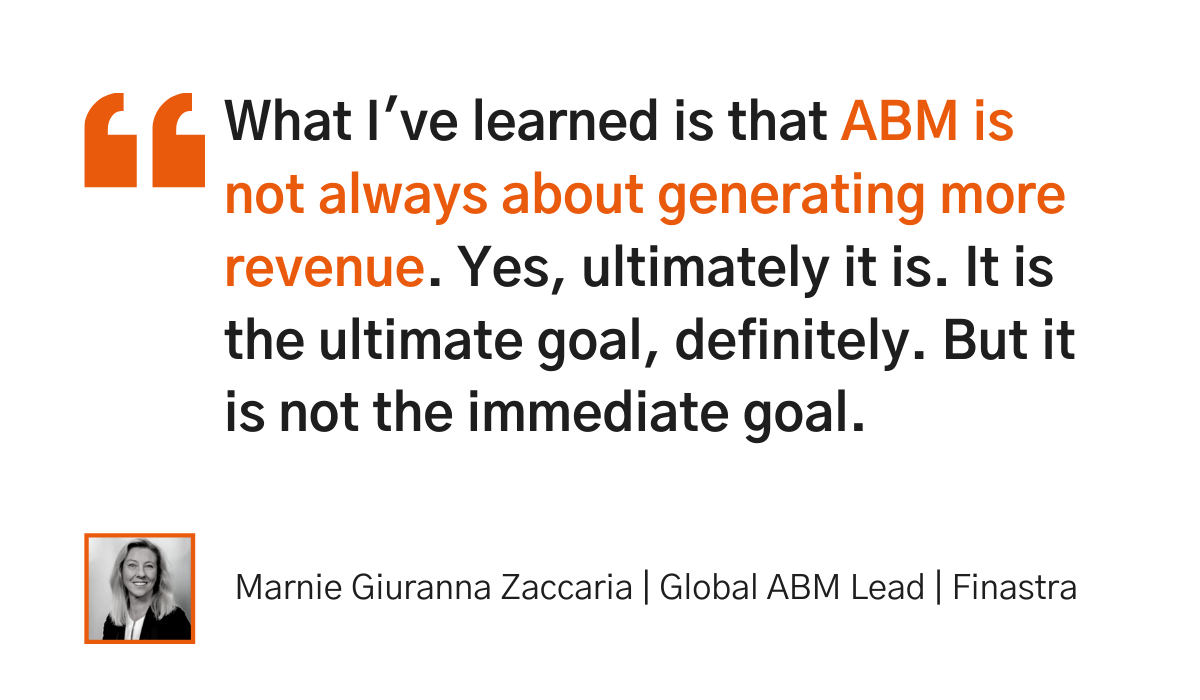We’re all fans of John Lennon, right?
Well this interview with Marnie Giuranna Zaccaria, who heads up ABM at global Fintech company, Finastra, makes me sing along to ‘Happy Christmas (War is Over)’.
So this is Christmas
And what have you done?
Another year over
And a new one just begun...
That’s got your attention, right?
So where’s the link between this legendary song and Finastra?
Marnie and her ABM team at Finastra have recently completed their first year of deploying an Account-based Marketing program.
It’s been a year of huge learnings, some mistakes, and a lot of successes.
I interviewed Marnie recently on my Let’s talk ABM podcast and we reflected on the last 12 months and ‘what she has done’.
In the interview (full recording here), we discussed:
- What the first year of an ABM strategy looks like
- Advice on what to do and what not to do in your first year
- How educating Sales helps to unlock ABM success
- Advice on how to succeed at Account-based Marketing
Let’s dive into Marnie’s top lessons learned for a successful ABM launch.
8 ABM lessons learned in 12 months
1. It's all about the account insights
It’s all about the insights. What insights?
The insights you commission on the industry, the sector, the client, the executive team.
You get it?
You simply cannot attempt to devise an account strategy when you don’t know the account and everything that is impacting them (or will impact them).
When ABM is all about targeted, hyper-relevant, and hyper-personalized experiences, guesswork isn’t going to cut it.
You need to know the who, what, why, where, and when of every target account.
- What are the key drivers for the industry?
- What changes are afoot?
- How is Account X positioned to deal with these changes?
- What are Account X’s competitors doing?
- Which department/subsidiary/etc of Account X is most receptive to your solution?
- Who are the movers, blockers, influencers, etc.?
- Where do these decision-makers ‘hang out’?
- What motivates them/moves them/excites them?
You get the point, right?
This is where your account insight becomes invaluable. Learn everything you can about your accounts, get to know them inside and out, and use this knowledge to drive your strategy.
There is so much more to commissioning account insights - it’s a huge part of what we do at the Agency and the value that it delivers to unlock the target accounts is immeasurable (actually scratch that - it is perfectly measurable in the results of an Account-based Marketing strategy.)
“We're definitely spending the majority of our time - and I really recommend anyone starting a program doing so - with account insights. I think it is really, really important. It's, you have to know - you can't build a targeted program if you don't know the customer, if you don't know what the customer is doing, what the strategy is. You simply can't.” - Marnie Giuranna Zaccaria, Global ABM Lead at Finastra
2. It's all about the roles and responsibilities
You have your Sales team.
You have your Marketing team.
So where does your ABM team fit?
Knowing how to integrate ABM into your wider business is a challenge faced by many new ABMers.
After all, ABM is the perfect mash-up of everything account-centric. It’s not just Marketing, and it certainly isn’t just Sales. It’s a strategic organization pivot.
So where does that leave us?
The best way to avoid confusion is to draft up a role chart, clearly stating every team’s responsibilities and roles within the organization and the ABM program.
Once you’ve clearly defined those roles, you can set out the processes, procedures, and KPIs for each team.
Officially documenting this makes it clear and transparent.
It’s not an unspoken understanding open to misinterpretation. It’s written and laid in stone, which means your teams know their roles and responsibilities and everyone is aligned.
Not only will this help to reduce miscommunication and lack of alignment, but will help to reinforce the idea of every team working together towards the same goal.
3. It's all about the accounts (and not too many!)
‘Eyes bigger than stomach’ syndrome applies to more than just food!
Many organizations have the same problem when it comes to ABM.
It’s easy to get excited and dive in at 100 mph (or 160 kph if you prefer metric..)
But do this, and you’ll quickly find that you are drowning in a sea of accounts.
When that happens, you’re no longer actually doing ABM - you’re just doing good (or bad) B2B Marketing.
The key is to stay focused, and start small.
This doesn’t mean you have to close yourself off from other target accounts and limit your potential. It just means you don’t go all-in within the first year.
ABM is a marathon, not a sprint. It’s all about the long game.
You can always adjust and add as you see fit, but you don’t want to be in a position where you bite off more than you can chew.
4. It's all about the objectives
Fail to plan...Plan to fail.
We’ve all heard this saying, right?
With ABM - you simply must set clear objectives and share these with everyone concerned.
With ABM, the revenue is not going to land on day one. ABM is a marathon and not a sprint (so be ready for the long game).
So you need to prepare the team, your management, the C-suite, etc. for what to expect and when.
What does ‘good’ look like?
ABM programs can span more than 12 months. In the case of Finastra - we’re even looking at three years. So it simply isn’t realistic to set the expectation that you’ll meet your end revenue target by the end of year one.
But what you can do is set clear markers of progress throughout the program. Smaller, more manageable goals that your team can work towards on your journey to that big win.
We talk more about these early indicators of success here in this ABM Metrics insight.

5. It's all about the team mentality
The key differentiator between ABM and traditional B2B Marketing is that ABM isn’t about Marketing.
It’s also not about Sales. Or the C-Suite. Or any other team within your organization.
It’s about the Account.
And that’s something that Sales understands.
After all, they’ve been speaking the language of accounts since long before ABM’s inception.
It all comes down to alignment.
With separate, siloed teams, you’re setting yourself up for miscommunication, misunderstandings, and misaligned processes, metrics, and goals throughout your ABM journey.
And no one wants that.
So do yourself a favor - skip the hassle, and cut straight to building a ‘one team, one goal’ mentality for your organization.
“We are one team, it's Marketing, and in the end we have the same goal, right?” - Marnie Giuranna Zaccaria, Global ABM Lead at Finastra
6. It's all about the engagement
Account selection is a major step in setting the foundations for your ABM program.
You have to invest a lot of time - because if you get it wrong, the rest of your program won’t matter.
You could have the best messaging and the most engaging creatives, but if you’re targeting the wrong accounts, none of it will come to fruition.
But of course, it’s easy enough to make mistakes. That’s why monitoring engagement is so important.
Your first year of ABM is the year in which you test, trial, and learn.
But you can’t do any of that if you aren’t keeping a close eye on engagement. If you can assess how engaged your accounts are with your content, you can then decide which are worth further investment, and which should be removed from the program.
“Have these selected accounts and monitor in the first three months the first results of the ABM program and the ABM activities. See the engagement, monitor the engagement of the account and the engagement of the Account Director. If both measurement pieces would not be satisfying, she would remove this account from the program.” - Marnie Giuranna Zaccaria, Global ABM Lead at Finastra
Ultimately, it all comes back to knowing your accounts.
7. It's all about education
Year one of ABM will come with its challenges.
One of which will be educating and training your teams.
Whether your organization is familiar with the world of ABM or is taking its first step into uncharted territory, your teams need to be brought up to scratch.
Making the transition from traditional B2B Marketing to ABM is a big step. It changes the entire structure of your organization, and that kind of transformation takes some adjustment.
When it comes to Sales, education is what secures buy-in, and ensures alignment.

Why? Because your Sales team will need convincing that ABM is the right choice.
They can’t fully buy into a program without understanding what it is, and what changes it will bring. So help them learn.
“We relied very much on the instructions they got from their managers. As you said, probably if they had done the business case it would have been better, but they didn't. And we organized two big education sessions to buy them in, to explain to them the value of ABM, how an ABM program works. And in the end it was definitely not enough. It was definitely not enough. We probably bought them in during the sessions, but then we kind of lost them.” - Marnie Giuranna Zaccaria, Global ABM Lead at Finastra
8. It's all about the Sales mindset
Here’s an interesting paradox: Account-based Marketing requires you to act with a Sales mindset.
This is probably where the name can cause some confusion; it’s Account-based Marketing, right?
But we like to think of ABM as ‘Account-based Everything’.
That’s because ABM involves everything, and works because you’re getting the best of both worlds - the creativity and analysis from Marketing, with the insight and charisma of Sales.
But what do we mean by acting with a Sales mindset?
Quite simply, it’s no longer about campaigns or MQLs.
It’s about building relationships.
That might be a hard pill to swallow for your Marketing team. After all, for years they’ve been focused on metrics like generating leads or boosting engagement.
But if you can reprogram your teams to act with a Sales mindset and center around building and nurturing relationships, then your first year of ABM will likely be a lot smoother.
Take a look at our Let’s talk ABM webinar and podcast series to hear some more key tips and tricks for taking on the world of Account-based.









